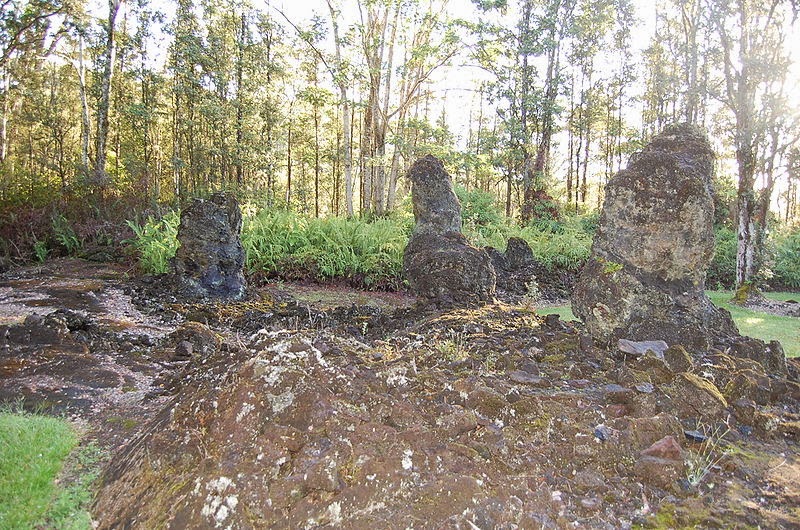The Lava Trees in Lava Tree State Park were created in a 1790
lava flow, which entered the area and buried the 'Ōhi'a Trees up to 11 feet
deep in molten lava. The Lava Tree State Park sits within the Nanawale Forest
Reserve in the lower Puna district near the town of Pāhoa. Although lava trees
can be found in several locations on the Big Island this particular park have a
number of exceptional examples as well as being very accessible.
When the hot lava from a volcanic eruption enters in a
forest, often it is observed that the lava does not overthrow the bigger trees,
but flows around them. Normally the moisture in the tree make cools the lava in
contact with the trunk and a hard exterior shell is molded. So as the lava
drains away, only the solidified “lava trees” are left standing. The intense
heat burns away the wood inside and a hollow cast in the shape of the original
tree is left behind. In particular cases, the tree can keep on standing and
stays for years as a black charred skeleton, and in sporadic cases, specific
trees even survive and continue to grow after the eruption. The finest example
of lava trees are originate on the island of Hawaii, in southeast of Pāhoa in
the Puna District.
Here, the whole forest of ohi’a trees was swamped in molten
lava up to 11 feet deep, when the Kilauea volcano erupted in 1790. The higher trees
that were surrounded by the molten lava cooled the lava that coated them, though
the heat of the lava began the tree to burn to ash. Therefore since then a close
fissure opened in the ground letting the molten lava to drain away back into
the earth. Nonetheless the lava surrounding the trees had already cooled and in
progress to harden and remained above ground as monuments to the trees that
once stood in the same spot. The forest of lava trees causing from eruption of
a one kilometer line of vents east of Pu‘u Kahaualea. The bulbous top of each
lava tree marks the high stand of the lava flow as it spread through the trees.
As the fissure eruption diminished, the flow constant to spread laterally; its shallow
subsided, leaving pillars of lava that had chilled against tree trunks.
Then spattering is from fissure out of view to the left. Note
blob of spatter following to the top of the stripped ‘ohi‘a tree. Nowadays, the
Lava Tree State Park contains of 17.1 acres of native plants, trees and several
lava trees. Several of the lava trees are well covered in moss, though others
have fallen to the ground, revealing their interior hollow structure. Specific
of the casts are so impeccable that you can still realize the imprint of the
bark in the lava rock itself.
The Lava Tree State Park is in the lower Puna district, and
to get to the park you need to take Highway 130 towards the town of Pāhoa, then
pass the first intersection that takes you into Pāhoa and at the next
intersection make a left onto Pāhoa-Kapoho Road. Follow this road for just
three miles until you see the park on your left. The park has a paved parking
lot and restrooms nearby from the parking lot. Moreover there is no drinking
water available in the park. The trail around the park is paved but is jagged
and broken in places due to tree roots. The trail is not navigable through its full
length by wheelchair. The Lava Tree State Park is at around 500 feet above sea
level. The climate conditions are wet though warm. Shorts and rubber slippers
or shoes are suitable. You might want to have light rain gear in the car in
cast it decides to rain. The park is open 24 hours a day, year round. There is
no cost to visit the park.





















































